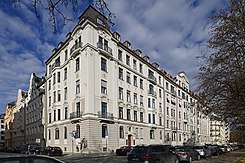Widenmayerstrasse
| Widenmayerstrasse | |
|---|---|
| Street in Munich | |
| Widenmayerstraße 4-6 | |
| Basic data | |
| State capital | Munich |
| Borough | Altstadt-Lehel |
| Name received | 1896 |
| Connecting roads | Maximilianstrasse , Ifflandstrasse |
| Cross streets | Steinsdorfstrasse, Gewürzmühlstrasse, Robert-Koch-Strasse, Liebigstrasse, Prinzregentenstrasse , Crusiusstrasse, Rosenbuschstrasse, Paradiesstrasse, Karolinenstrasse, Tivolistrasse |
| Numbering system | one-sided numbering |
| use | |
| User groups | Pedestrian traffic , bicycle traffic , individual traffic |
| Technical specifications | |
| Street length | 1.5 km |
The Widenmayerstraße is a city road in the Munich district of Lehel . It is registered as a listed ensemble in the Bavarian list of monuments.
location
The street is on the eastern edge of the Lehel. It runs along the Isar from the Maximiliansbrücke to the Max-Joseph-Brücke . To the east of Widenmayerstrasse is the Isar promenade with the Isarkais .
history
Before 1890 there were only two buildings on the street, which at that time was still called Äussere Isarstraße. These were No. 11, a three-story eaves-sided house built in 1877, and No. 15, Villa Hanfstaengl built in 1888. Both buildings were destroyed in World War II.
Around the same time as the banks of the Isar were fortified with quay walls, the road was further developed from 1893/94, which was named in 1896 after the mayor of Munich, Johannes von Widenmayer , who died in 1893 . The inner Isarstraße running parallel to this along the Hofhammerschmiedbach was abandoned and the building plots were added, the creek itself was vaulted and partly built over.
The development was mainly from south to north, initially in the style of late historicism , then baroque and classicizing . By 1899, the two southernmost building blocks up to Robert-Koch-Strasse had been completed. In 1900 the northernmost house (no. 52) was built on the corner of Tivolistraße, which only got a southern neighbor 12 years later.
The gym of the gymnastics and sports club Jahn Munich was built in 1904 as the only building between Widenmayerstraße and Isar . It initially remained in ruins after the Second World War and was only demolished in 1962/63 for the planned widening of the street.
Apart from houses No. 10 (1902) and 12 (1905/06), building was not continued until 1909. In 1911–12, the uniform assembly No. 46–51 was set back from the alignment of the other buildings and erected at an angle across from it. Most of the buildings were erected at the beginning of the First World War , but the last vacant lot (No. 17) was not closed until 1986.
The damage caused by the Second World War varied greatly: some houses were only slightly damaged, others could be repaired, others had to be completely demolished. The new buildings erected there are at least adapted in height to the surroundings.
The workshop in the courtyard of the Widenmayerstraße 2 building was the location for the carpenter's workshop of Meister Eder for the television series Meister Eder und seine Pumuckl .
description
Widenmayerstrasse is only built on on its west side. The buildings are numbered consecutively, so that both even and odd house numbers are on this side. The buildings are usually four to five storeys high.
The Isar promenade east of the street is lined like an avenue by two rows of trees. A bicycle path runs between the Isar promenade and the street, and there are parking strips on both sides of the two-lane street.
Highlighted structures
Some corner buildings are particularly highlighted, e.g. B. by a round pavilion or a tower tower on the street corner.
Many of the buildings in Widenmayerstraße are also listed as individual monuments . In detail, these are the buildings with house numbers 1 , 2 , 3 , 4, 5, 6, 7, 8, 9, 10, 12 16, 18, 23, 25 / 25a , 27, 28, 29, 31, 32, 34, 36, 37, 38, 41, 42, 43, 44, 45, 46a, 46 staircase I, 47, 48, 49, 50, 51 and 52. Numbers 46–52 are at the wider northern end of the street and form a uniform assembly, the back of which is on the Eisbach .
The buildings with house numbers 3 (2007), 10 (2003), 16 (1999), 23 (2007) and 28 were awarded the Facade Prize of the City of Munich . The building with house number 9 received an honorable mention as a publicly owned building (2005).
traffic
The Widenmayerstraße is part of the Isarparallele, which forms a cross connection within the Middle Ring from north ( Kennedybrücke ) to south ( Brudermühlbrücke ) and from there continues south to the Thalkirchen district , where it leads to Bundesstraße 11 .
For a large part of its length, Widenmayerstraße is a one-way street from south to north. The parallel street Emil-Riedel-Straße, Oettingenstraße and Sternstraße takes traffic from north to south. Only the northern part, where the underpass under Tivolistraße begins, is passable in both directions.
literature
Heinrich Habel, Johannes Hallinger, Timm Weski: State capital Munich - center (= Bavarian State Office for Monument Preservation [Hrsg.]: Monuments in Bavaria . Volume I.2 / 1 ). Karl M. Lipp Verlag, Munich 2009, ISBN 978-3-87490-586-2 , p. 24, 1208 ff .
Web links
Individual evidence
- ^ Widenmayerstraße at the Bavarian State Office for Monument Preservation
Coordinates: 48 ° 8 ′ 16.4 " N , 11 ° 35 ′ 27" E



